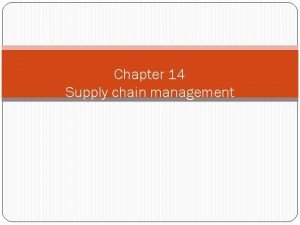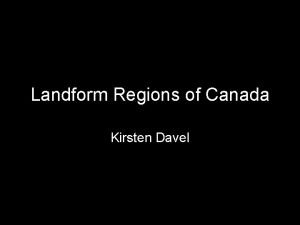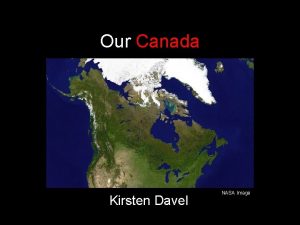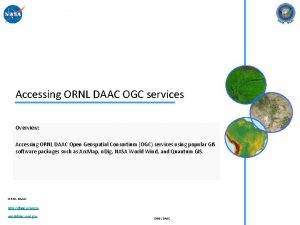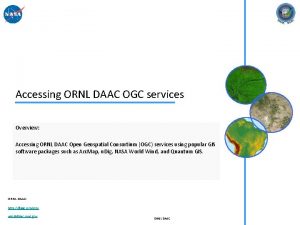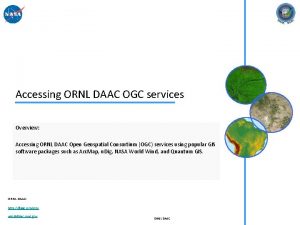Climate of Canada Kirsten Davel www csm ornl














- Slides: 14

Climate of Canada Kirsten Davel www. csm. ornl. gov/

Defining Climate • Climate is the average condition of the atmosphere i. e. : it is the long term pattern of weather • Climate influences: – Where we live – What farmers can grow – The clothes we wear – How we construct buildings www. arcticphoto. co. uk www. ars. usda. gov http: //canadianworldtraveller. com/

Weather • Weather is the temporary condition of the atmosphere i. e. : it changes hourly www. met. utah. edu

Canada’s Climate • Canada’s climate is so varied because of its – Great north-south extent – Different elevations – Coastal regions and continental regions – Wind and pressure systems which move weather across the country Making Connections p. 143

The Influence of Latitude • Latitude refers to the distance from the Equator • As latitude increases, temperature and precipitation decrease i. e. : there is an inverse relationship www. spaceforspecies. ca www. usatoday. com

The Influence of Relief and Elevation • Relief refers to the presence of mountain barriers to the movement of air masses – E. g. : Vancouver has cool, rainy weather in winter whilst Calgary has cold, dry weather • Elevation refers to the height of the land above sea level www. le-ecotours. com – the higher the elevation, the lower the temperature – the higher the elevation, the possibility of more precipitation www. newagepersonalcareassociation. com

Continental and Maritime Climates • Areas in the interior of continents which are far from the ocean and large lakes, have a continental climate – Hot summers and cold winters (i. e. : a large annual temperature range) – lower rainfall than coastal areas • Places at the coast or on the shores of large lakes, have a maritime climate – Warm summers and cool winters (i. e. : a small annual temperature range – The possibility of higher precipitation • Why? Large bodies of water have a moderating effect on land temperatures and provide the water source for rainfall

The Influence of Ocean Currents • Warm ocean currents bring warmer temperatures and moist air to coastal areas • Cold ocean currents bring cooler, drier conditions to coastal areas www. physicalgeography. net

Air Masses • An air mass is a large volume of air that has the characteristics of the area where it formed www. srh. weather. gov/ – E. g. : c. P (continental polar) air is cold and dry – E. g. : m. T (maritime tropical) air is warm and moist http: //members. aol. com

Forms of Precipitation • • • Rain Snow Hail Fog Dew Frost Sleet Drizzle Freezing rain www. hprcc. unl. edu/ www. wrh. noaa. gov www. calstatela. edu http: //project 1. caryacademy. org/ www. physicalgeography. net http: //thomashawk. com

Precipitation • Air cools as it rises • As air cools, water vapour condenses into clouds • When the raindrops become too heavy to be suspended in the atmosphere, it rains • Air rises when – A mountain forces it to rise (relief/orographic precipitation) – It is heated and expands (convectional precipitation) – Denser cold air meets lighter warmer air and forces it to rise (cyclonic precipitation)

Orographic Precipitation http: //earth. geol. ksu. edu/ • Air rises in order to cross mountains • Rising air cools, condensation occurs and clouds form • Rain occurs on the windward side of the mountain barrier (wet climate e. g. : Vancouver) • As air descends the leeward side of the mountain, it warms, therefore evaporation occurs • A rain shadow occurs on the leeward side of the mountain barrier (dry climate e. g. : Calgary)

Convectional Precipitation http: //atschool. eduweb. co. uk/ • • The sun heats the ground and warm air rises As the air rises it cools and water vapour condenses to form clouds As the hot air continues to rise, large cumulonimbus clouds form Heavy rain storms occur. These usually include thunder and lightning due to the electrical charge created by unstable conditions. Sometimes hail occurs • Convectional precipitation is common on the Prairies of Canada in summer

Cyclonic Precipitation www. physicalgeography. net • The colder air mass is more dense than the warmer air mass, so carries on pushing forward along the ground • The warmer air mass is lighter than the colder one so is forced to rise over the advancing cold air mass • As the air is forced to rise, it cools and water vapour in the air condenses to form clouds • Further forcing of the air upwards causes precipitation to occur. • These storms move from west to east through Canada and in winter bring most of the precipitation • The 1998 Ice Storm was a large cyclonic storm
 Ornl olcf
Ornl olcf Ornl webmail
Ornl webmail Michelle buchanan ornl
Michelle buchanan ornl Ornl cades
Ornl cades Climate change 2014 mitigation of climate change
Climate change 2014 mitigation of climate change What factors shape the climate in canada
What factors shape the climate in canada Natural vegetation regions
Natural vegetation regions Csm foot
Csm foot College of san mateo concurrent enrollment
College of san mateo concurrent enrollment Csm grugliasco
Csm grugliasco Chapter 8 body mechanics and patient mobility
Chapter 8 body mechanics and patient mobility Requirente
Requirente Mitel csm
Mitel csm Csm chapter 14
Csm chapter 14 Csm-ra
Csm-ra













